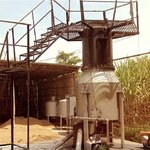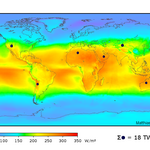Energy

There are 20,000 miles of pipeline in Nebraska criss-crossing the Ogalalla aquifier. A company wanted to add 400 more but President Obama overruled scientists and declared the addition environmentally risky. So the Keystone XL extension did not happen and the president who promised to promote more domestic oil came across as a political obstructionist for blocking it due to...why exactly? No one knows, really. Because he wanted to prove he can do nothing right and still get re-elected, I suppose. I bet he can.
But to at least make an effort to placate his liberal union base…

We all want fewer dictators getting rich holding the world hostage to the demands of legacy energy systems. And it can happen, though one anti-science contingent might not like how it gets done.
The hydrogen economy has been ready to start for decades and could begin commercial production of hydrogen in this decade - but, says Dr. Ibrahim Khamis of the International Atomic Energy Agency (IAEA) in Vienna, Austria, it will take heat from existing nuclear plants to make hydrogen economical.
Khamis said scientists and economists at IAEA and elsewhere are working intensively to determine how…

Composition of radiant heat
Both conduction and convection are ways of carrying heat from one place to another which require the presence of a material substance, either solid, liquid or gas.
Greenhouse
There is a third process of heat transmission which does not require a material medium. This is called radiation, and is the same means by which energy travels from the sun across the empty space beyond earth's atmosphere. Radiant heat consists of invisible electromagnetic waves which are able to pass through a vacuum. These waves are partly…

The human demand for energy began long ago when apes metamorphosed into the first of what after another million years of evolution would become homo-sapiens. Survival was tough in the beginning, but things changed after fire was harnessed. This resulted in an extension of the domain of the human race on this planet. The invention of agriculture around 10,000 years ago finally led to human settlements and civilizations, which flourished due to a steady source of nourishment.
As the process of agriculture and farming came to be automated, rural populations began moving towards growing cities.…

Introduction
Solar energy, accumulated under earth in the form of fossil fuels since the inception of life, accounts for more than 97 per cent of the world consumption of energy of which the share of oil is about 39 per cent. The biomass accounts for 43 per cent of the total energy supply in the developing countries as compared to only 1 per cent in the developed countries ( Hall, 1982). With the present rate of consumption of 65 million barrels of crude oil per day and projected estimates, the present crude reserves may be badly depleted within the next 40 years. The energy costs for…

Like global warming? You can thank nuclear power protesters. Since the 1970s, a full-scale public relations war on nuclear power has been waged, meaning a growing population became more reliant on fossil fuels instead of zero-emissions nuclear power.
Now, a formal complaint about subsidies for nuclear power has been sent to the European Commission (DG Competition). If it is upheld, it unlikely that any new nuclear power stations will be built in the UK or elsewhere in the EU. The complaint may be followed by legal action in the courts or actions by politicians to reduce or…

If you don't think the government should be artificially mandating winners and losers among clean energy companies with artificial subsidies, don't let that turn you off of basic research, where the real improvement in future clean energy will be made.
A discovery by military and academic researchers that embedding charged quantum dots into photovoltaic cells can improve electrical output by enabling the cells to harvest infrared light, and by increasing the lifetime of photoelectrons, may mean dramatically increasing the amount of sunlight that solar cells convert into electricity.
The idea…

In Bihar, one of the poorest states in India, 85 percent of people are not connected to the electricity grid so households use kerosene lamps when they can afford it and businesses use expensive and dirty diesel generators.
Some view this 'energy poverty' as a development problem, others view it as an environmental problem. The founders of Bihar-based Husk Power Systems view it as an opportunity to build a social enterprise.
Their motto is tamaso ma jyotir gamaya - ‘from darkness to light’
Husk Power Systems realized that one waste product in Bihar, rice husks, could be used to power a small…

Solar photovoltaic (PV) mass-market polycrystalline panels are typically about 15% efficiency. Pretty terrible, right? Maybe, maybe not.
Cars - both gasoline and electric vehicles, despite what the electric car hype machine claims - are only slightly more efficient at 15-25%, as is eating, and biology had all of existence to perfect that process. Ethanol and other biofuels, which were the darling of anti-science environmentalists in the Anything-But-Oil camp before electric cars because they are the ultimate solar-powered device, are a dismal 2% efficiency.
Yet maybe an…

Breathe in, Breathe out, charge your implant. It sounds like a dream, but researchers at the University of Wisconsin-Madison report that the simple act of human breath can create enough energy to power a small biomedical device.
Currently, the devices that keep us alive – at least the ones that we can carry around with us – run on batteries. And while batteries work well for cell phones, toys, and cars, their inherent limitations create problems in the human body. Most critically, batteries are not forever. Recharge and replacement become risky when a battery is buried deep inside a body.…